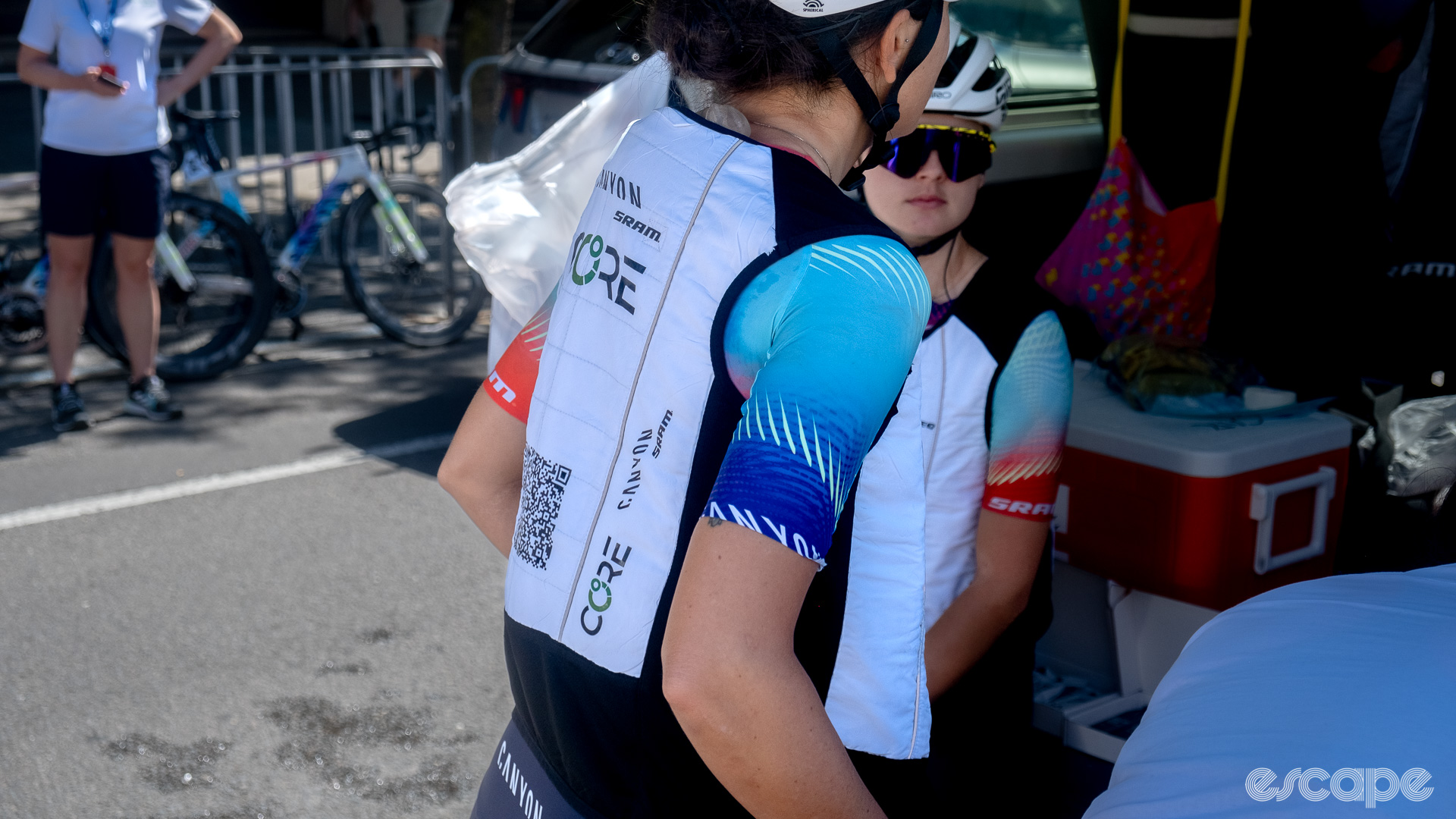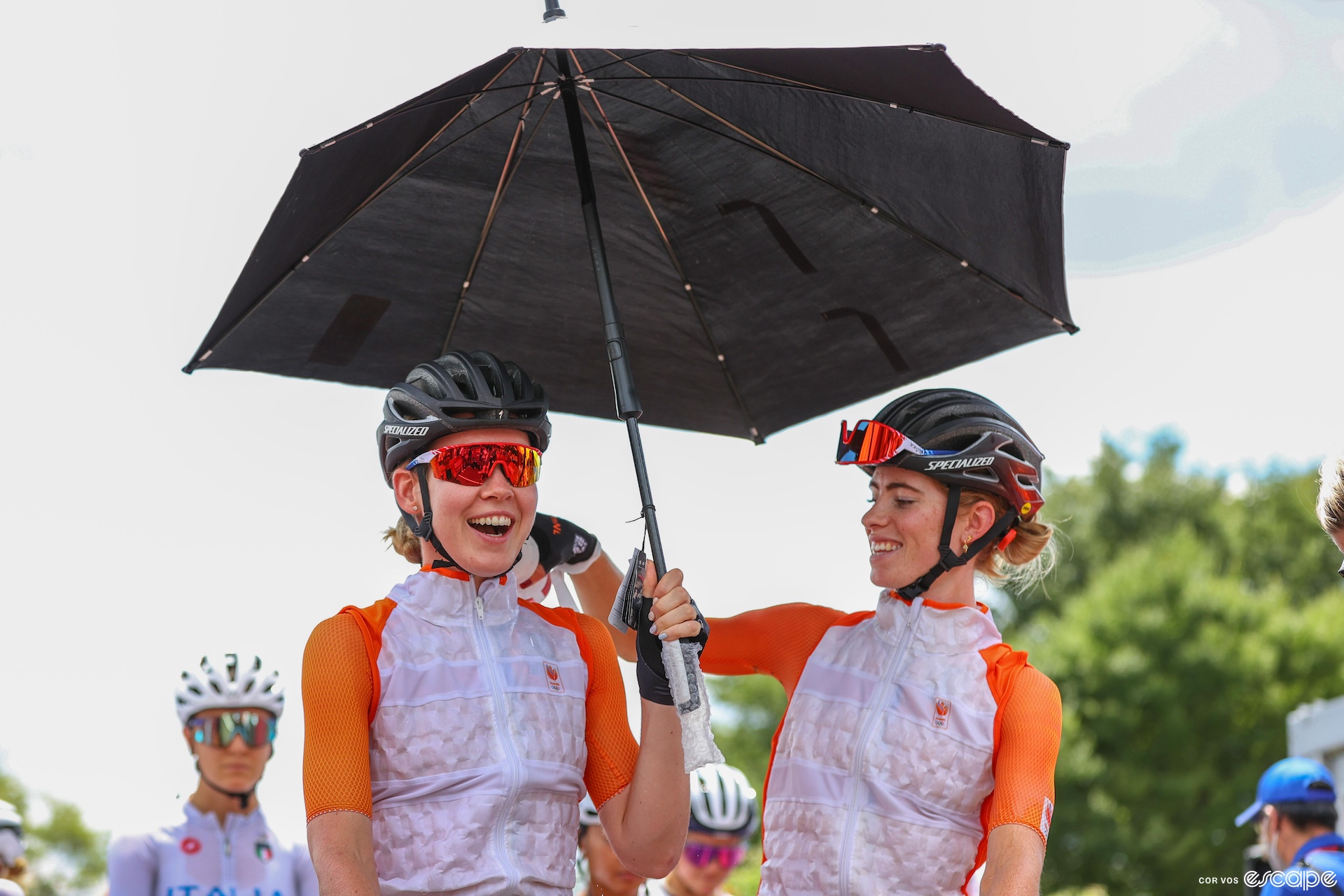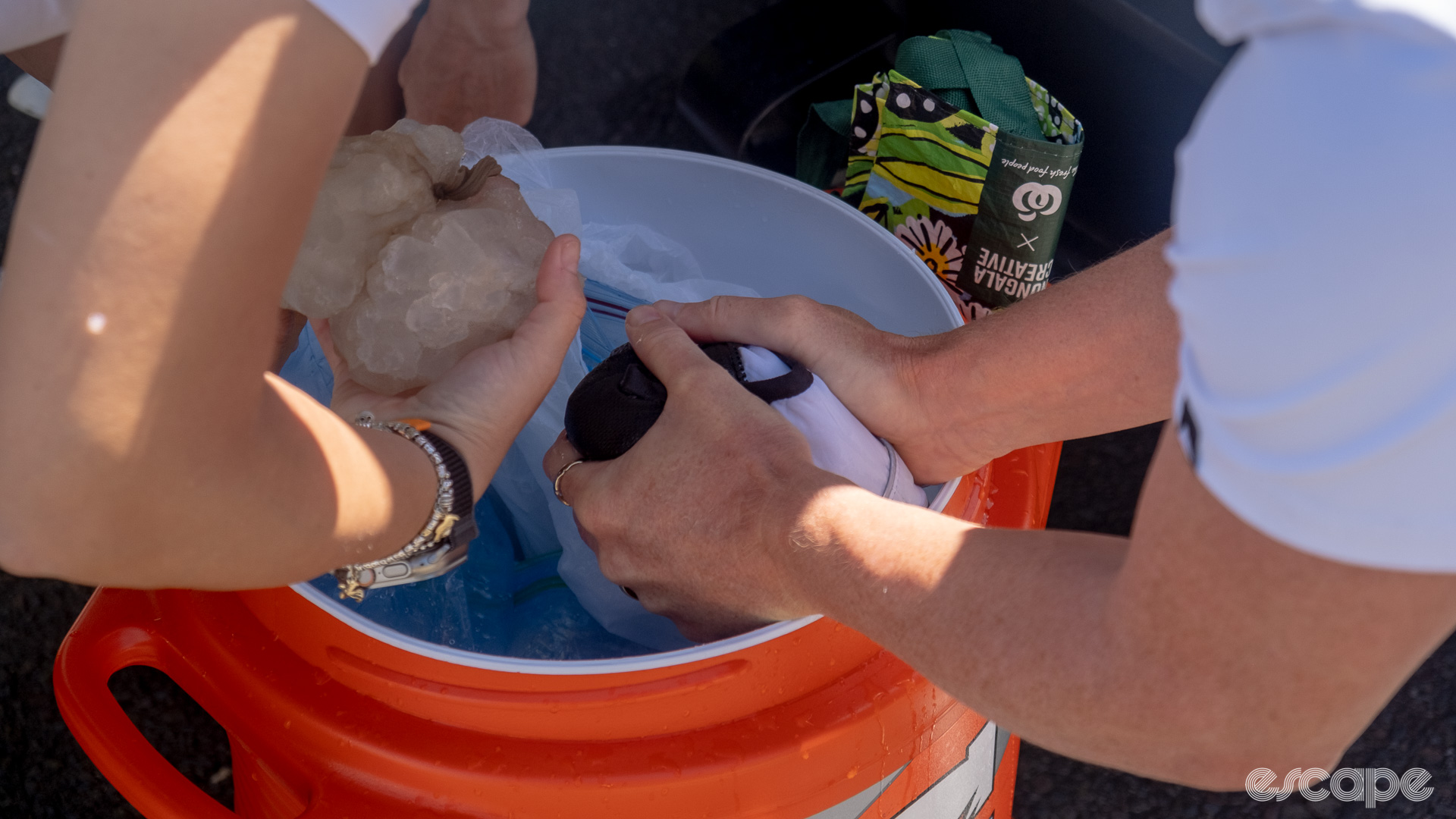While heat adaptation strategies and tech such as core body temperature measurement devices, cooling vests, ice baths, and even cooling bar tape are ever more common in women’s and men’s pro pelotons, the research backing up different methods is still in its infancy – especially so when it comes to their efficacy on female athletes.
A 2024 audit of heat adaptation research found that females accounted for only 13% of 7,707 participants across 477 studies examining heat adaptation strategies and their effects on core temperature, heart rate, and aerobic performance. Furthermore, only 13% of those female participants were highly trained athletes.
Why heat train, and what’s different for women?

When we exercise, our bodies generate heat. This heat production is amplified in hot environments, leading to a rise in core body temperature. In short, if the body cannot dissipate this heat effectively, performance suffers. While temperature plays a big part, other conditions such as humidity and intensity also contribute to the physiological strain of exercising in the heat.
Beyond sex differences, factors like body size, surface area, sweat rate, and clothing also influence heat dissipation. Taller, leaner individuals generally dissipate heat more efficiently due to a larger surface area relative to body mass, while excess body fat can act as insulation, making it harder to cool down. Women, on average, are smaller and have a higher body fat percentage than men – both factors that can make heat dissipation more challenging.
Core – a company providing a number of WorldTour men’s and women’s teams with core body temperature sensors, has recorded substantial differences in the measured core body temperatures between the men and women, despite similar riding conditions of the female riders.

For example, when Core compared data from men’s stages three to nine of the 2024 Vuelta a España, which had hot weather, with data from stages of the Tour de France Femmes, which had cooler weather, they found that female athletes spent more time with higher core temperatures than male athletes, even though the women’s stages were shorter and raced in cooler temperatures.
“The women in the Tour spent an average of three to four hours with their core temperature in the ‘fever zone’ [temperatures above 38°C], while the men in the Vuelta spent less than two hours in this zone, despite racing longer stages in hotter temperatures,” Aline Barre, endurance performance lead at Core told Escape.

This could indicate that women might not either respond to the cooling strategies or heat adaptation in the same way as men or that those strategies are simply not tailored enough for female athletes. Yet, it’s hard to draw any definite conclusions from just these comparisons, as variables present in bike races extend beyond the temperatures.
“Even though the stages of the females are shorter and the temperatures have been lower, it’s super difficult to take any comparison because depending on just the humidity and so on, it’s just not possible to compare it,” Puck Alkemade, a physiologist at Core adds. “It would be quite interesting to have a look also into the humidity, for example, because if that was quite similar, it’d be quite an interesting observation. Because let’s assume that the women pushed less power – then you would expect that their heat production is less than the men but if they still get hotter this would suggest that they lose less heat.”
Puck and Barre were hesitant to say outright that the data they’ve collected indicates a correlation between sex and heat response, but they did agree that there are differences related to body temperatures.
For example, research has frequently shown that hormonal fluctuations during the menstrual cycle can influence core body temperature and sweating responses. Women’s resting core temperature can increase by approximately 0.3°C during the cycle’s luteal phase – that’s the time from the day after ovulation until the day before the period starts.
The use of hormonal contraceptives also adds another layer of complexity to measuring body temperatures in female athletes. Different types and doses of hormones in contraceptives can have varying effects on thermoregulation, and more research is needed to fully understand how these factors interact with heat stress and adaptation in female athletes.
For example, a 2021 study on the “sex differences in adaptation to intermittent post-exercise sauna bathing,” focusing on trained middle-distance runners, found that “females may require longer duration exercise-heat acclimation protocols or a greater heat stimulus to induce heat acclimation.”
Where is the research?

To really analyse the findings from races and for teams to find tailored cooling strategies, more research on female cyclists is needed. Heat adaptation research is trending up in numbers, but it’s lacking in female participants, especially at the elite level.
“An important aspect of undertaking these studies is to ensure we are not just adding ‘quantity’ of research to the field; rather we are conducting female-based research of ‘high quality’ and answering well-developed research questions,” Monica Kelly, a lecturer in Applied Sports Science at Deakin University, told Escape in an interview.
Kelly is one of the authors of “Auditing the Representation of Females Versus Males in Heat Adaptation Research” study – a study that looked at 477 studies published from the beginning of heat adaptation research up to February 2023. These studies included a total of 7,707 participants and only about 13% of those participants were female. They further concluded that “only 10% provided some evidence of appropriate methodological control to account for ovarian hormone status, with no study meeting best-practice recommendations.”
That might seem a stark finding, but it’s unfortunately not an aberration in the sports science field. A study speficially on “Heat Adaptation for Females” also pointed out that “Recent [sports science] publications highlight the substantial under-representation of females with just 4–13%.” At the same time, things are getting better, too.
“There has been a focus on female research in recent years. However, there is certainly a way to go before we understand the unique physiology of females and their impact on many disciplines in life, including sporting performance,” Kelly says. “This is where research papers, like our recent systematic review, led by PhD candidate Lilia Convit at Deakin University, can profile the current body of knowledge, identify gaps in the field, and guide future research.”
But even where the heat mitigation studies have included female participants, the findings might not correlate to what could’ve been the experiences of highly trained, elite individuals. The Kelly review noted that most female participants in heat studies where exercise training tiers were listed fell into tier zero (sedentary) to tier two (trained/developmental). Just 133 female test subjects across all studies were classified as tier three (highly trained/national) to tier five (world class).
“While there is a growing body of female research, the participants are often of recreational or trained status (e.g., cycling as a hobby or for local competition), which may limit the application of some research findings to our elite female athletes,” says Kelly. “We need to better understand the needs of our elite female athletes by directly undertaking research (that is applicable) to this population group. However, that is easier to say than do given the high number of race days [and] time constraints of these athletes and prioritising performance. The time to complete research is very limited and we need to ensure we are asking good questions and conducting high-quality research when we have the opportunity.”
Core’s Alkemade and Barre echoed Kelly’s point about the difficulty of using data collected at races. Even though there might be a lot of it, racing conditions are necessarily uncontrolled and variables like weather conditions, race dynamics, and individual rider variations make it difficult to isolate the effects of specific cooling techniques.
What methods are the women’s teams using?

When speaking with Core, it became clear that while some of the women’s professional teams are quite advanced with their cooling strategies, others are lagging far behind and do barely anything to mitigate the impact of heat on riders.
That means that currently there is no uniform, clear way for professional teams to perform heat adaptation and cooling, nor do all riders for example take part in heat training before the season starts, either. This is even though monitoring the effect that these measures can have on the athletes’ performance has become easier and even if it is lacking in detail and number, there is research to back up some core heat adaptation strategies.
The reason for some teams not adopting heat protocols isn’t clear, but a lack of resources came up with all sources Escape spoke with. And when you take a look at all that goes into a fully executed heat strategy, outlined below by Kelly, it’s easy to understand why.
“When coaches and athletes identify a race in the heat, there are some immediate factors to consider. This can include the time available for preparation, including number of days and/or weeks prior to the race in the heat,” she says. “This can include the time available for heat preparation at their regular training base for heat acclimation but also time available when arriving at the race location. For example, athletes who are travelling from the European winter to Adelaide for the Tour Down Under in January (Australian summer) may decide to first commence heat acclimation training at their home base, and arrive with sufficient time to adapt to the heat in Australia.
“If this travelling strategy is not feasible, then using heat acclimation training at home and matching the conditions to what may be expected on ‘race day’ e.g., temperature, and humidity can be useful strategies to implement. As race day approaches, the focus likely shifts to heat mitigation and resources required prior to, during and following the race. A plan for pre-race nutrition, timing of warm ups, ice towels/ice vests, in-race nutrition and hydration, and after crossing the finish line when to jump in the ice baths, re-fueling and hydration strategies for recovery and preparation for the next day/race.”
Women’s WorldTeams Canyon-SRAM Racing and Human Powered Health told Escape they have implemented comprehensive heat protocols, like using ice vests pre-race, providing riders with ice socks during stages, and ensuring optimal hydration. But while these two teams have made progress, at the same time, many teams do not use cooling vests when riders are waiting at the start line, even when the temperatures are high – something that can lead to riders experiencing heat stress even before the race even begins.

Dan Fleeman, a performance director at Canyon-SRAM, said that the monitoring of the riders’ core body temperatures and implementing a cooling strategy has played an important part in the team’s success in the last two years – and it’s made it easier to analyse results.
“In the past – when I was racing for example – I’d have bad days and it’d be in the heat and I wouldn’t necessarily think it’s related. I’d just think it was a bad day, whereas now we can correlate the data and say, ‘Okay actually look, she was approaching 39 degrees at this point and, that’s why she went through this bad moment,’” Fleeman explains.
The increased research conducted on women will undoubtedly make the recommendations and practices more readily available for all teams and individualised for each rider, which will benefit not only the performance but the health of the riders, too.
When asked if Canyon-SRAM has plans to change up the ante on this front going into 2025 season, Fleeman said, “I think we’ll just do more of the same, but put a bigger focus on riders’ heat adaptation. It’s something we’ve done with some riders and other riders a little bit less, but as time goes on, it will become more commonplace for sure.”
Did we do a good job with this story?

